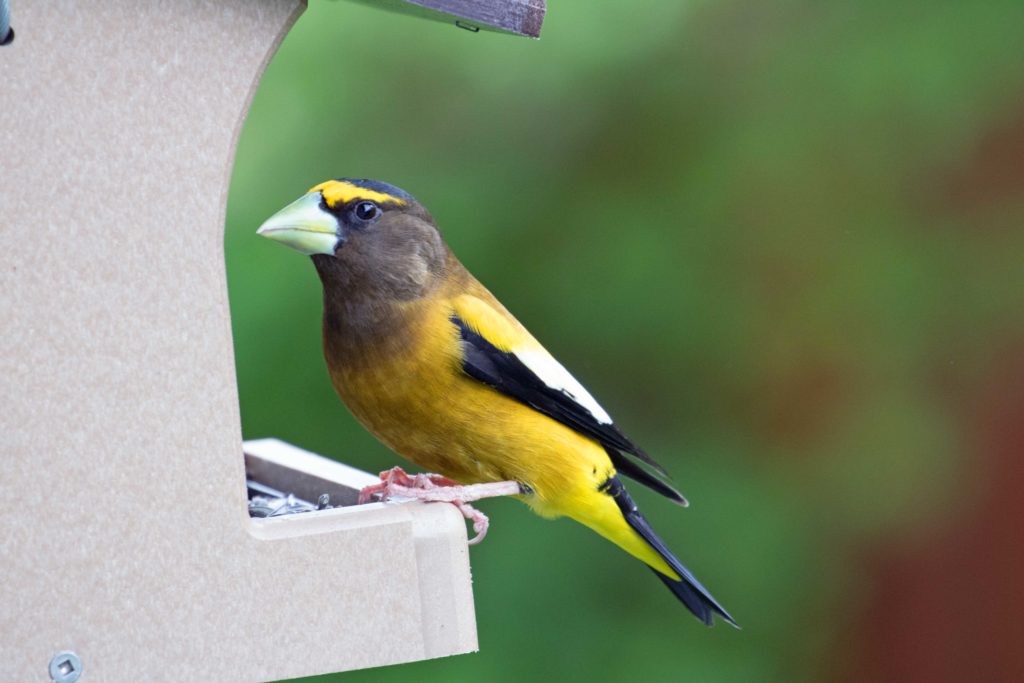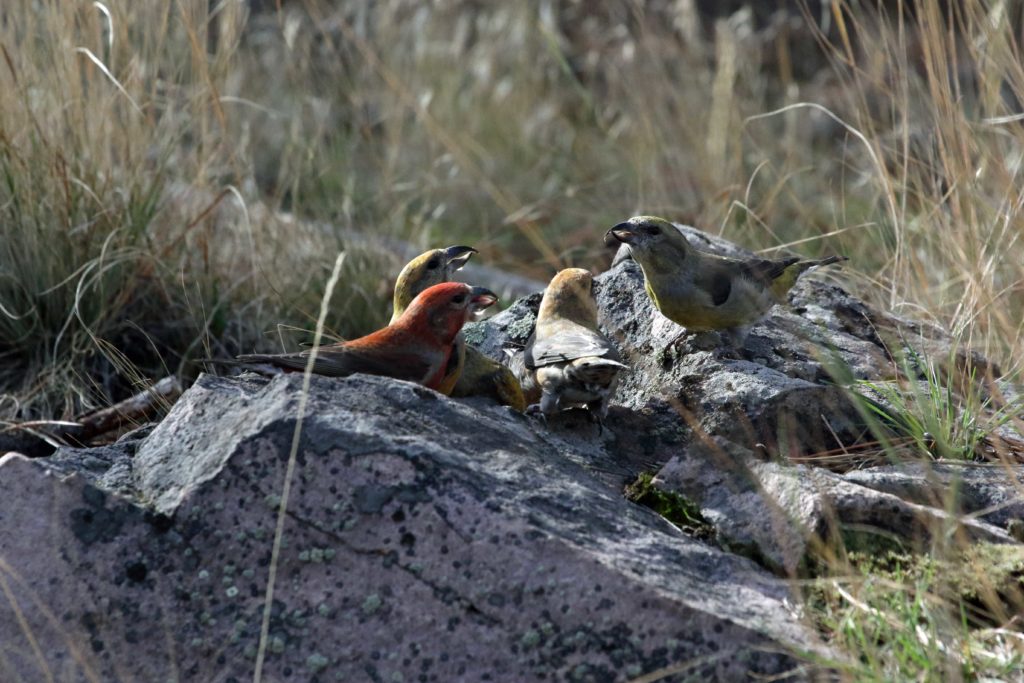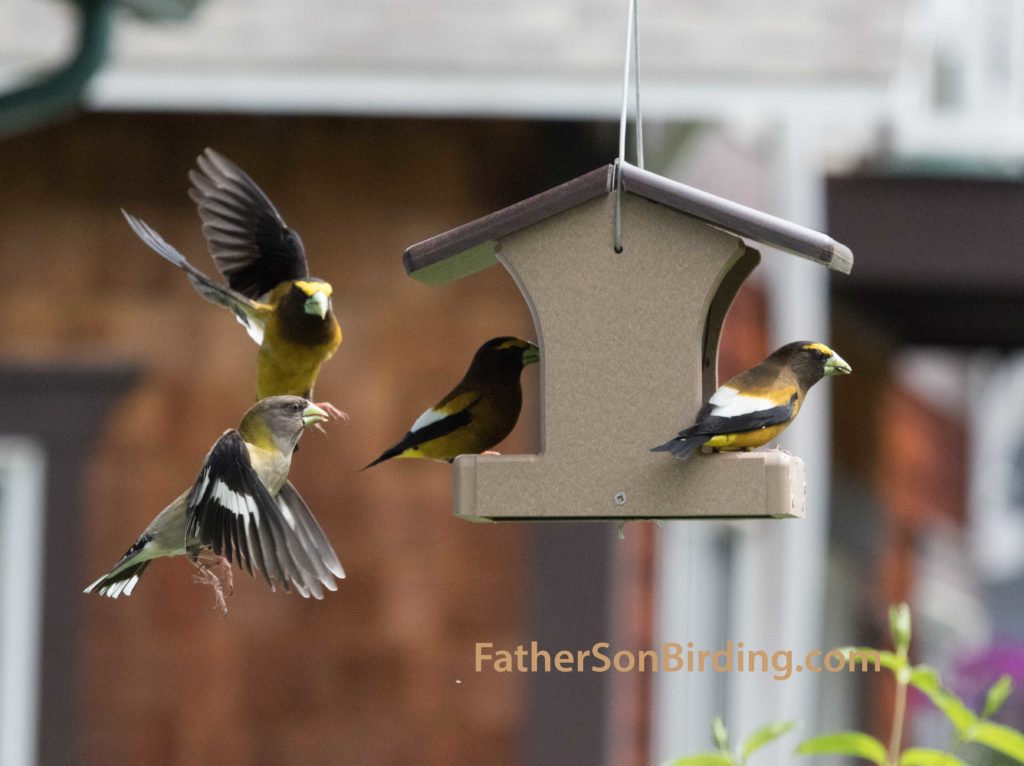
This year, there are more Evening Grosbeaks than ever at our feeder–but still nowhere near the amount we saw our first year of birding. (photo by Braden Collard)
Braden here.
During our first year of serious birding, my dad and I thought Evening Grosbeaks were common. Every day in fall, if you just walked the block from our house to Rattlesnake School, you would be amazed at the numbers of these boisterous finches gathered there. There were hundreds, maybe even a thousand of them in their drab fall plumage, tearing apart any pinecone unlucky enough to be spotted.
Two years later, during our first major Big Year (which you can read about in my dad’s fall book Warblers and Woodpeckers: A Father-Son Big Year of Birding), we saw only two individuals: a pair we briefly glimpsed up Pattee Canyon while staking out an American Three-toed Woodpecker nest.
How is it possible that we saw tons one year and only 2 another year? Irruption.

Red Crossbills are another boreal finch that has irruption cycles. (photo by Sneed B. Collard III)
When I say irruption, I’m not talking about a misspelled version of the thing happening in Hawaii right now. An irruption is a mass migration of birds (in this case) to a different area, generally south. Finches are the main type of group that has irruption cycles, but many birds that winter in the U.S. and southern Canada, such as Snowy Owls, Rough-legged Hawks, Bohemian Waxwings and Northern Shrikes also irrupt. Irruption almost always results in large numbers of birds appearing in areas where they normally aren’t, however it isn’t historically unusual.
One of the main reasons for irruptions is food supply. For example, when there aren’t enough rodents to go around up north in winter, Snowy Owls will generally move south into Northern U.S. states. Sometimes, if the shortage is extreme enough, the northern birds will extend their ranges past their usual limits and end up in places that are unheard of. During a major Snowy Owl irruption year, for instance, Snowies were found as far as Texas and Hawaii.
Irruptions can occur due to food abundances, too. The year before we experienced the Evening Grosbeak overload probably had pairs producing higher amounts of young than usual. The next year, the young had nowhere to go, since all of the territories up north were filled, so they moved south into Missoula.

While not as big of an irruption year as before, this year’s Evening Grosbeaks are costing us plenty in bird seed! (photo by Sneed B. Collard III)
This year and last year haven’t quite met that first year’s standards yet, but it has seen crazy irruptions for tons of finches. Last winter kicked off with large numbers of grosbeaks and Pine Siskins, while this year Common Redpolls, Cassin’s Finches and (yet again) more grosbeaks are stealing the stage. Who knows what will show up next?

I actually had never heard of this before. Do you know if the birds start off on their normal route and then change it gradually as they find less normal food, or do they maybe find a lot more of a better food early on and then “decide” to go with the better food (which takes them on a different route for the rest of the year)?
Lots of good questions, and I can only speculate. I think irruptions often happen from a season’s good food supply, leading to a lot more babies–or, as you indicated, either a windfall “cash crop” or failure of a traditional crop. We hope to learn more about it over time. Last summer/fall, for instance, we had unusually large numbers of Clark’s Nutcrackers, and we think it was either a failure of a higher-altitude crop or just a really great year for Ponderosa pine cones.
Fascinating, Braden, and so well written!
Very interesting. Hadn’t heard of this. I was shocked by your snowies in Hawaii example. They really go that far, and over open ocean? I’m amazed they could travel so far over open ocean to a tropical climate that is not what they’re adapted to.